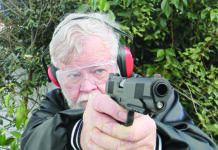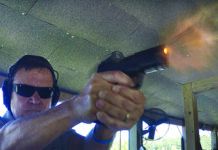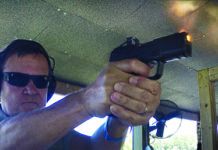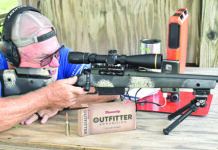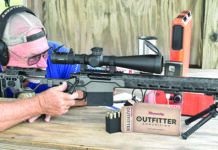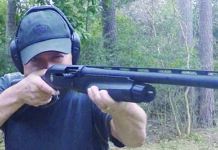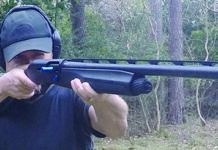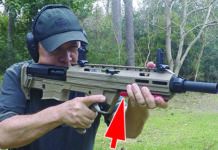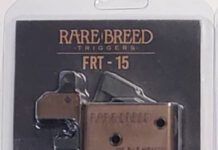One of the biggest problems facing gun owners today is lack of available ammunition. Recently, a member of our staff was shopping the hunting department of a big-box store and overheard a customer say he was going to buy a gun based on whatever ammunition was still on the shelf. Always pragmatic, our interest in one such round, 7mm Remington Magnum, actually began when a SWAT recruit for a major metropolitan police force sought training for USPSA 3-Gun competition from a member of our staff. The officer mentioned that his family has been hunting with bolt-action rifles chambered for 7mm Remington Magnum since the cartridge was introduced in 1962. Often described as being housed in a 338 Winchester case necked down to 7mm, characteristics such as an abundance of power and a flat trajectory were at the center of the family’s appreciation for the round.
But we learned of another application that really piqued our interest. According to acclaimed law-enforcement trainer Brian Hoffner (www.hoffners.com), we learned that the 7mm Remington Magnum bolt-action rifle was also a key weapon in tandem with dart gun and shotgun for ZDART, acronym for Zoological Dangerous Animal Response Teams. This means providing lethal force in an emergency to stop “medium”-size animals such as lions, tigers, and bears in an urban setting.
So we took a look at Browning’s $1019 X-Bolt Medallion No. 035200227. It did not arrive with sights, but was drilled and tapped for scope mounts and had proprietary mounts and rings. It was built with stained walnut and featured removable box magazines.
Our test ammunitions were Winchester’s 150-grain Super X Power Point and two rounds from Federal. They were Federal Premium Vital Shoks featuring Nosler’s 160-grain Accubond bullet, and Federal Classic ammunition topped with Sierra’s 160-grain Pro Hunter soft point.
Our test procedure called for five-shot groups fired from a distance of 100 yards with the rifles supported upon a bench rest. We consider this plan to be standard procedure. But in speaking with even the most avid hunters, they expressed that firing more than two consecutive shots at prey was unlikely. One extra shot at an elk scurrying away may even prove to be the full extent of the day’s shooting. But we weren’t about to report on two-shot groups. Another comment we heard was that considering the recoil of magnum ammunition and the expense (about $1.75 to $2.50 per round on average), the average hunter wouldn’t be spending a lot of time on the practice range, either.
The rifle was treated to a brief but careful break-in regimen. Dedicating 20 rounds of ammunition, we cleaned and lubricated the barrel after the second, fifth, ninth, fourteenth and twentieth round. We then proceeded with our shooting of groups, cleaning the barrel after every two groups. However, we were forced to work under extreme conditions. Houston, Texas was in the middle of a drought with record temperatures that simply would not go away. Using a Kestral 4000 weather station from Sinclair International (www.sinclairintl.com), we measured temperatures at our shaded bench that ranged from 90 degrees to in excess of 102 degrees. Occasional winds gusting to about 8 mph were easy to wait out. First shots each day at American Shooting Centers (www.amshootcenters.com), began at approximately 9:30 a.m. Each firing session lasted 20 minutes. Working under these constraints we fired a shot about every 3 minutes. Overpowered by the heat, we ended each day’s session by about 1:30 p.m. We used Caldwell’s Tip Top Targets for their ability to cut a sharply defined bullet hole and fit neatly into a ring binder for later reference. Here is what we learned.
In viewing our Browning rifle we were immediately reminded that each of our four rifles was markedly different in terms of look and feel. The X-Bolt Hunter Medallion cut a slender profile with tapered barrel and a glass-like finish upon its stock. We learned throughout our tests that the sleek finish was as durable as it was refined. The fore end offered wraparound checkering that was decorated on the bottom but only covered about halfway up the sides of the stock. Above the fore end the 26-inch barrel (with 1:9.5-inch twist) was separated by a gap about four dollar bills thick that ran all the way back to the receiver. Checkering also graced the sides of the pistol grip. The safety consisted of a sliding lever located atop the pistol grip. Currently there are no left-handed X-Bolt rifles, but the safety was easily accessible to both right- and left-handed shooters. Furthermore, the forward edge of the comb was relieved on each side and a matching contour was carved into the bottom of the butt stock. Quick-release sling swivels were in place front and rear. A cushy rubber buttstock measuring about 0.8 inch thick at its center was in place. This was Browning’s Inflex Technology butt pad. The Inflex recoil pad did a good job of moderating recoil, but we still preferred to wear a shoulder pad for added protection.
The action was accented by a gold-colored trigger. This was Browning’s adjustable Feather Trigger. We left it at its factory setting of about 4.75 pounds. Removing the bolt required pressing inward on the release lever located on the left side of the receiver. The bolt was mirror-finished chrome and showed virtually no wear points at the conclusion of our tests. The bolt could also be removed with the safety on by pressing the Bolt Unlock Button located on the bolt lever itself. The button was inconspicuous and did not interfere with the Medallion’s styling. It blended nicely with the flat contour that ran along the right side of the receiver.
Lockup was accomplished by three visible lugs forming an A-pattern, which had us wondering why this rifle was referred to as an X-Bolt. According to Browning the term X-bolt does not refer to a physical attribute such as the shape of the bolt or a pattern formed by its lugs. It was more a matter of marketing a rifle with a collection of extra features, including the new X-Lock Scope Mounting System. The X-Lock was a two-piece mounting system consisting of CNC-machined scope rings with an integral base that bolted directly to the drilled and tapped receiver of the X-Bolt rifle. Made for Browning by Talley, a widely respected name, each mount connected to the receivers with four Torx screws. The X-Lock mounts proved to be an excellent fit. It felt like we didn’t even have to tighten the bolts completely for a secure fit. The X-Lock mounts are available in a variety of heights and colors fit for both 1-inch and 30mm scopes. Cost of the X-Lock system was $60 from www.Browning.com.
The Medallion fed from a three-round removable box magazine of polymer construction. The magazine release was found at the forward edge of the magazine. Actually, the latch was a part of the magazine and not the rifle.
The technique for loading rounds was similar to filling a pistol magazine. Rather than press each round downward directly through the feed lips you first depressed the follower, (or the last round loaded), and slid the next round into the magazine from front to back. Bolt action and feeding was flawless.
At the range we learned that the X-Bolt Medallion was consistent when firing the Winchester 150-grain rounds, but much more accurate firing the heavier 160-grain bullets found atop the Federal ammunition. The Federal Vital Shok ammunition fired a 0.8-inch group on the way to a computed 1.1-inch average. The Federal Classic ammunition kept all groups within the 1.1-inch to 1.3-inch range. We think the free-floated barrel on the X-Bolt helped it maintain accuracy throughout the extreme heat.
Our Team Said: Given the Browning’s penchant for heavier bullets, we couldn’t help but wonder what kind of accuracy would have been delivered by the 175-grain rounds preferred by the ZDART teams mentioned earlier. Nevertheless, the Medallion was a beautiful rifle that inspired confidence with each shot. From the standpoint of looks and performance, we can’t imagine anyone being unhappy with an X-Bolt Medallion.



